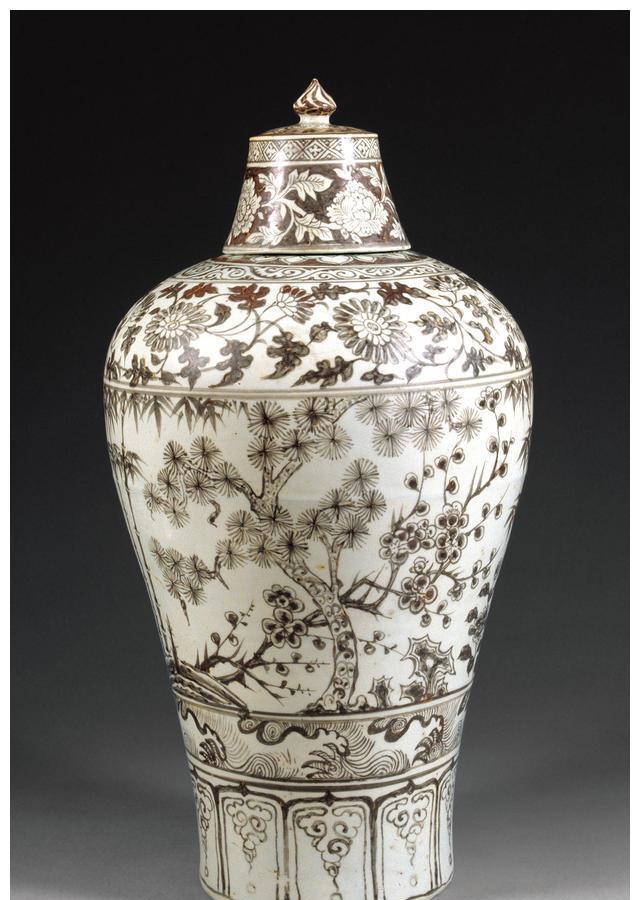The Nanjing Museum has a collection of more than 430,000 pieces of various cultural relics, of which nearly half are porcelain, and the red year cold three-friend pattern plum bottle in the Ming Hongwu glaze is one of the rare fine works. As the only complete Ming Hongwu glaze in existence, this porcelain has a red ribbon lid plum bottle, with a hard tire, beautiful shape, exquisite ornamentation, and moist enamel. Its white glaze is slightly blue, although the glaze red hair color is slightly black, but the flaws do not hide Yu, in 1993 by the State Administration of Cultural Heritage as a first-class cultural relics, is the treasure of the Nanjing Museum.

Ming Hongwu glaze red age cold three friends pattern plum bottle
In the Ming Dynasty, plum bottles have been used as important funerary items by the royal family and nobles. So, who is the owner of the red plum bottle in the glaze of the Minghong Wu Jingdezhen official kiln? What kind of story is hidden behind it? What is its important value in the history of porcelain development?
The bottle is prominent - the owner of the plum bottle
In March 1957, archaeologists discovered a Ming Dynasty tomb near Xianglong Mountain in Dongshan Bridge, Nanjing. The 47 cultural relics unearthed in the tomb are mostly common daily necessities, including several copper products and tin cans, bottles, pots, plates, plates, etc. The shape of the instrument is small, the shape is simple, and the production is rough. However, in these humble cultural relics, archaeologists were pleasantly surprised to find a hongwu glaze red age cold three friends pattern plum vase. This exquisite and complete plum bottle looks beautiful in these ordinary funerary products, which makes people's eyes light up at the same time, but also makes people wonder: Who is the owner of the tomb? Why do you have such high-quality funerary products? What is certain is that the owner of the tomb must have cherished this plum bottle very much before he died, and he would take it with him to bury after death.
Ming Hongwu glaze red year cold three friends pattern plum bottle ornament unfolded part of the schematic
The excavated epitaphs indicate that the owners of the tomb were Song Hu and his wife Princess Ancheng in the early Ming Dynasty. There are few records in the history books about Song Hu and his wife Princess Ancheng. Song Hu was the second son of Song Sheng (1342-1407), the founding general of the Ming Dynasty, and Princess Ancheng was the daughter of Zhu Di, the ancestor of Ming Dynasty. In the first year of Yongle (1403), Zhu Di paired Princess Ancheng with Song Hu. In the sixth year of Yongle (1408), Song Hu succeeded his father as marquis of Xining and guarded Gansu. In the tenth year of Yongle (1412), Song Hu was ordered to return to Beijing and perform the filial piety sacrifice as an imperial relative. In the first year of Hong Xi (1425), Song Hu was impeached for disrespectful and stripped of his title until Xuande's death in the fifth year (1430). In the eighth year of orthodoxy (1443), Princess Ancheng died of illness and was buried together in DongshanQiao.
Behind this Ming Chengzu Zhu Di horse is an unknown Song family. The Song family is a meritorious family that founded the Ming Dynasty, and the merits of Song Sheng are the most prominent. Song Sheng, Zi Jingyang, Anhui Dingyuan people. Since childhood, he fought with his father Song Chaoyong and his eldest brother Song Guoxing, following the Ming Emperor Zhu Yuanzhang in his conquests. Successively serving as the commander of Jianning, Jiangxi, Datong, and Shaanxi, the town guarded Liangzhou for more than 20 years, and fought countless battles with ethnic groups outside the Country, with many achievements. After Ming Chengzu ascended the throne, Song Sheng was promoted to the post of Governor of the Rear Army, zuo du du (左都督), a general of Bai Pingqiang, and decided to make decisions on northwestern border affairs. In the third year of Yongle (1405), he was the Marquis of Xining and hereditary. Yongle died of illness in the fifth year (1407) and was posthumously awarded the title of "Duke of Yun".
Song Sheng's meritorious service was outstanding and he was trusted by two generations of emperors. At the beginning of the Ming Dynasty, Zhu Yuanzhang, the ancestor of the Ming Dynasty, implemented the marriage policy of "the daughter of the prince and the son of the princess and the minister". In the first year of Yongle (1403), Song Sheng returned by edict, and Zhu Di paired his daughters Princess Ancheng and Princess Xianning with Song Sheng's sons Song Hu and Song Ying. The appearance of two lieutenants in the Song clan shows their political status.
After Song Sheng's death, his descendants inherited the title of "Marquis of Xining", passed on eleven generations, and recorded fourteen people until the death of The Ming Dynasty. In the seventeenth year of Chongzhen (1644), Zhu Yousong (1607~1646), the Hongguang Emperor of the Southern Ming Dynasty, posthumously made up the title of "Duke of Ningguo". It can be said that the Song family witnessed the rise and fall of the Ming Dynasty.
Author: Shebo